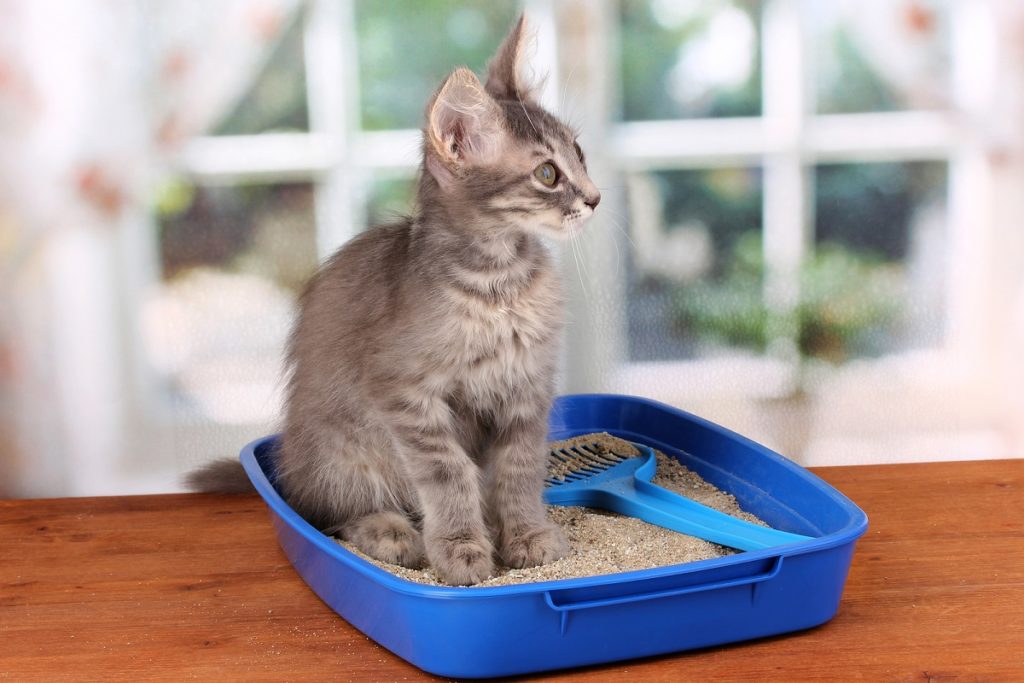Contrary to popular belief, you can indeed train a cat, and one of the first things pet owners should train their cat to do is to use the litter box. But since cats are so notoriously independent, you might wonder how to litter train a cat.
The good news? It’s really not that difficult and is perhaps the single most important thing to train your cat to do. Even the most stubborn of cats can be trained to use a litter box.
In this post, we’re going to walk you through the process of how to train a cat to use a litter box so you’ll be ready when you bring a new feline friend home.
Expect Accidents to Happen
Luckily, cats are naturally very clean animals, and there is a decent chance your cat may already be litter trained before they come home with you. In this best-case scenario, all you’ll need to do is buy a box big enough for your cat and some litter.
However, it’s important to note that even if you are told your new kitten has already been litter trained, you shouldn’t be surprised if an accident happens. New surroundings or a new litter box can take some time to adjust to. If your kitten has an accident, remember that it’s part of the course, and to not punish him. Praise the kitten when he successfully uses the litter box and perhaps even offer a small reward, but avoid punishing, as it may prolong the behavior.
How to Litter Train a Cat: The Set-up
Sometimes, you won’t be so lucky, and end up with a kitten who has yet to be litter trained. Not to worry! Just follow the steps below.
First, it’s important to understand the basic set up requirements for your cat’s litter box. You can’t just drop the thing down wherever you’d like and expect your cat to be fine with your choice. Cats are private animals and can be rather picky about where they prefer to go to the bathroom, so it will actually take some careful consideration when preparing your cat’s litter box.
And if you already have cats in your home, you might think you’re all set and they can just share a litter box, but this isn’t the case. You will need to get your new kitten its own litter box as well. In fact, it’s actually best to have one more litter box than the number of cats in the house. So if you have two cats, you’ll need three litter boxes, and so on.
Cats don’t like to share, and this gives them another option should they require one for any reason. Some cats won’t use a litter box that other cats have used, even if they are family members, while others may use one box to urinate in and another for number two. Having the extra box eliminates any problems that may arise should your cat be fussy about where he eliminates.
Does it Matter Where You Place the Litter Box?
It does! Not only is the number of litter boxes important, but location also matters. You will want to make sure you put your cat’s litter box, or boxes in a quiet, calm location that is easy for your cat to access. It should be away from any noisy household appliances and not in an often-used room in your house.
The litter box location should also provide your cat with a bit of privacy, and far away from your cat’s bed or food.
The Size & Type of Litter Box
 Of course, there is a wide variety of litter box options available, including self-cleaning boxes, covered boxes, or boxes designed to fit into corners. Whatever option you choose, the most important thing to consider is that the box is the right size for your cat. If the box is too small, your cat will not want to use it.
Of course, there is a wide variety of litter box options available, including self-cleaning boxes, covered boxes, or boxes designed to fit into corners. Whatever option you choose, the most important thing to consider is that the box is the right size for your cat. If the box is too small, your cat will not want to use it.
Likewise, you need to make sure older cats or kittens can easily access their litter box. Boxes with lower sides are ideal, so your geriatric cat or kitten won’t have to jump to get into his litter box.
Some cats will prefer to have a litter box with a cover, and you may want a covered box if your cat likes to bury their waste deep in the litter, tossing litter around everywhere. Hooded boxes also tend to do a better job of containing odor.
The Type of Litter
Generally, cats seem to prefer fine-textured litter that has the consistency of beach sand or garden soil. Cats are also very sensitive to smell, so you may run into issues with scented litters and might be better off choosing unscented. However, this will vary from cat to cat.
As for how much litter to use, you actually don’t want to fill up the box, rather just use a couple inches of litter and change it more frequently. When you have a new cat, you can use a couple of different litter options to see what he prefers.
How to Make Adjustments
Because cats can be picky about their litter box, you may have to make some tweaks as you go along in your litter training. You may have to switch the type of litter, change the box to one with lower sides, add or remove the litter box cover, or move the boxes to quieter, more secluded areas. You may also simply need to clean your cat’s litter box more often to make them more appealing.
But with this prep work done, you should be ready for the actual training portion of getting your cat to use a litter box.
Training a New Cat or Kitten to Use a Litter Box
Luckily for pet owners, cats do have a natural instinct to go to the bathroom in sand or soil, and will often learn to use a litter box by observing their mother. Cats can learn to use the litter box as soon they are as young as three or four weeks old, so your kitten may very well be litter trained by the time you bring him home.
Training a kitten to use his litter box is not quite the same as housebreaking a puppy, but will require a similar level of attention.
First, you need to familiarize your kitten with the location of his litter box. Of course, you should confine kittens to smaller areas of your home at first, rather than allowing them to roam freely, so you will want to keep the litter box within their area. Make sure they know where their litter box is in their new surroundings, and make sure the box is easy for them to reach.
Right after you bring your kitten home, introduce them to their litter box at a quiet time. You should literally place your kitten into the box, and can even gently show your kitten how to scratch at the litter a couple of times. If the kitten jumps right out, that’s okay, don’t get discouraged.
Simply place the kitten in the box a few times throughout the day when a cat would normally need to go to the bathroom, such as first thing in the morning when they wake up, right after meals, after playtime, or getting up from a nap. Since cats prefer privacy when using their litter box, you also should not hover over your kitten when you want them to go. Rather, you should leave your kitten alone once you see they have started to use it. Praise them or offer a treat once they have finished.
Frequent accidents, cat diarrhea, or having a kitten who seems to have difficulty going to the bathroom may indicate some underlying health issues that you should have your veterinarian look into.
How is Litter Box Training a Cat Different Than Potty Training a Dog
 Well, simply, it’s usually much easier, especially if the kitten is already litter trained when you bring him home, since all you will need to do is get the kitten familiar with the location of his new litter box. However, even those kittens who still need to be taught should catch on faster than potty training a dog, and it will require less work, simply by the fact you don’t need to take your kitten outside several times throughout the day.
Well, simply, it’s usually much easier, especially if the kitten is already litter trained when you bring him home, since all you will need to do is get the kitten familiar with the location of his new litter box. However, even those kittens who still need to be taught should catch on faster than potty training a dog, and it will require less work, simply by the fact you don’t need to take your kitten outside several times throughout the day.
Much like you would take your puppy outside immediately if you see him going to the bathroom in the house, you should quickly pick up a kitten that you see eliminating outside of his box and place him into the litter box. Ge gentle and don’t yell at your kitten, as it will frighten him and may cause him to associate the litter box with punishment, and this is the opposite of what you want. You will need to use an enzyme-based cleaner for any accidents, as kitten waste can be quite powerful.
Another clever tactic is to pick up the waste and place it into the litter box, so your kitten can see that that’s where it should go.
Step-by-step Litter Box Training
Many cat owners won’t ever have to do much training at all, as kittens will often learn from their mothers how to use a litter box, but you can use the following mini-guide to train your cat or kitten to use their litter box should they require any help.
- The most important thing you can do to ensure your cat eliminates regularly is to make sure your cat eats a healthy diet and has plenty of water available in their bowl at all times.
- Make sure to keep your cat’s litter box in a clean, quiet, confined area, so they can peacefully eliminate away from any noise or distractions. This includes other pets and family members, so be conscious of the location you choose and what typically goes on in that room.
- While covered boxes are great and generally preferred once your cat learns, an uncovered box may be preferable during training. The box should also be easy for a kitten to enter, so make sure the sides are low enough that they don’t have to leap into the box.
- Should you kitten have an accident and eliminate outside of the box, clean up the mess, but place the waste inside the box if you can, and make sure the kitten sees you do it.
- Place your kitten in his litter box frequently throughout the day, and praise him whenever he properly eliminates in the box. After a couple of days, the kitten should begin to understand that this is where he is supposed to go to the bathroom and walk over to the box on their own. If he doesn’t, continue placing the kitten in the box right after meals or waking up until he catches on. You may even try a different type of litter or litter box location.
If nothing seems to work, consult your veterinarian, as there may be a health issue that is causing your kitten’s behavior.




